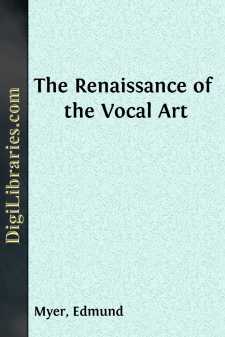Categories
- Antiques & Collectibles 13
- Architecture 36
- Art 48
- Bibles 22
- Biography & Autobiography 813
- Body, Mind & Spirit 142
- Business & Economics 28
- Children's Books 17
- Children's Fiction 14
- Computers 4
- Cooking 94
- Crafts & Hobbies 4
- Drama 346
- Education 46
- Family & Relationships 57
- Fiction 11829
- Games 19
- Gardening 17
- Health & Fitness 34
- History 1377
- House & Home 1
- Humor 147
- Juvenile Fiction 1873
- Juvenile Nonfiction 202
- Language Arts & Disciplines 88
- Law 16
- Literary Collections 686
- Literary Criticism 179
- Mathematics 13
- Medical 41
- Music 40
- Nature 179
- Non-Classifiable 1768
- Performing Arts 7
- Periodicals 1453
- Philosophy 64
- Photography 2
- Poetry 896
- Political Science 203
- Psychology 42
- Reference 154
- Religion 513
- Science 126
- Self-Help 84
- Social Science 81
- Sports & Recreation 34
- Study Aids 3
- Technology & Engineering 59
- Transportation 23
- Travel 463
- True Crime 29
The Renaissance of the Vocal Art
by: Edmund Myer
Description:
Excerpt
ARTICLE ONE.
THE OLD ITALIAN SCHOOL OF SINGING.The Shibboleth, or trade cry, of the average modern vocal teacher is "The Old Italian School of Singing." How much of value there is in this may be surmised when we stop to consider that of the many who claim to teach the true Old Italian method no two of them teach at all alike, unless they happen to be pupils of the same master.
A system, a method, or a theory is not true simply because it is old. It may be old and true; it may be old and false. It may be new and false; or, what is more important, it may be new and yet true; age alone cannot stamp it with the mark of truthfulness.
The truth is, we know but little of the Old Italian School of Singing. We do know, however, that the old Italians were an emotional and impulsive people. Their style of singing was the flexible, florid, coloratura style. This demanded freedom of action and emotional expression, which more largely than anything else accounts for their success.
The old Italians knew little or nothing of the science of voice as we know it to-day. They did know, however, the great fundamental principles of singing, which are freedom of form and action, spontaneity and naturalness. They studied Nature, and learned of her. Their style of singing, it is true, would be considered superficial at the present day, but it is generally conceded that they did make a few great singers. If the principles of the old school had not been changed or lost, if they had been retained and developed up to the present day, what a wonderful legacy the vocal profession might have inherited in this age, the beginning of the twentieth century. Adversity, however, develops art as well as individuality; hence the vocal art has much to expect in the future.
THE DARK AGE OF THE VOCAL ART.Even in the palmiest days of the Old Italian School, there were forces at work which were destined to influence the entire vocal world. The subtle influence of these forces was felt so gradually, and yet so surely and powerfully, that while the profession, as one might say, peacefully slept, art was changed to artificiality. Thus arose that which may be called the dark ages of the vocal art,—an age when error overshadowed truth and reason; for while real scientists, after great study and research, discovered much of the true science of voice, many who styled themselves scientists discovered much that they imagined was the true science of voice.
Upon the theories advanced by self-styled scientists, many systems of singing were based, without definite proof as to their being true or false. These systems were exploited for the benefit of those who formulated them. This condition of things prevailed, not only through the latter part of the eighteenth century and the first half of the nineteenth, but still manifests itself at the present day, and no doubt will continue to do so for many years to come.
The vocal world undoubtedly owes much to the study and research of the true scientist. All true art is based upon science, and none more than the art of voice and of singing....


